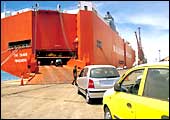 |
| Crucial
doorway :
The Chennai Port, like the rest of its ilk, is antiquated
and expensive |
India
is steadily emerging as a global auto manufacturing hub. The government
harbours ambitions of replicating China's model of becoming the
world's factory. But port infrastructure, that crucial doorway
to the global marketplace, doesn't support these grandiose dreams.
The harsh reality: Indian ports are small, antiquated, bureaucratic
and expensive. In Chennai, Hyundai complains that apart from the
capacity crunch at the city's port, it also has to pay through
its nose to send cars out, thereby partially neutralising the
cost advantage that India provides. Says S.S. Rangnekar, Director,
Shipping Corporation of India: "Indian infrastructure is
woefully inadequate, not only in the ports but also in terms of
road and rail linkages (to ports)."
The good news is that government is alive
to these problems. It has drawn up an ambitious Rs 60,338.53-crore
plan (individual break-ups below) to expand capacities and to
bring Indian ports up to global standards. This investment will
help increase existing (2004-05) traffic flows of 384 million
tonnes (MT) to 706 MT by 2013-14. Total port capacity will then
be 918 MT. This is in keeping with the international benchmark
of having 30 per cent excess capacity in order to avoid congestion
and delays.
Global
Dreams, Local Problems
Here's a peek at what's going on in some of
India's major ports.
VISAKHAPATNAM,
Andhra Pradesh
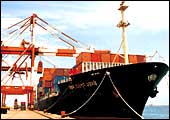 Capacity:
50 MT Capacity:
50 MT
VESSEL SIZES: 1,50,000 DWT
TURNAROUND TIME: 3.2 days
INVESTMENTS: Rs 3,544 crore
DWT: Dead weight tonnes
Visakhapatnam
is essentially a bulk cargo handling port. Users feel it is quite
safe as it has no mafia, but complain that the port lacks adequate
storage space. Adds a Vizag Steel Plant official: "The depth
of the channel should also be increased to facilitate the entry,
exit and handling of Panamax vessels at the inner harbour berths."
The authorities are aware of these problems. "Tenders are
being floated for the development of storage sheds and warehouses,"
informs Visakhapatnam Port Trust Chairman K. Ratna Kishore. Plans
have also been made to deepen and widen the inner harbour entrance
channel in two phases. According to officials, the volume of traffic
is expected to increase to 84 MTPA by 2014. The port mainly handles
iron ore, pellets, POL (petroleum oil lubricant), coking and thermal
coal, fertilisers and some general cargo.
-E. Kumar Sharma
KANDLA, Gujarat
CAPACITY: 42 MT
VESSEL SIZES: N.A.
TURNAROUND TIME: N.A.
INVESTMENTS: Rs 4,985 crore
Kandla Port,
which is located in the Kandla creek, is a protected natural harbour,
and mainly serves the states of Gujarat, Rajasthan, mp, Haryana
and Punjab. The port, which has 11 operational cargo berths at
present, handled in excess of 40 MT of exports and imports for
the third year running in 2004-05. It is now looking to expand
capacities in a big way: it plans to add nine additional berths
over the next five years and is also partnering with public and
private sector companies to set up additional cargo handling facilities.
According to Kandla Port Chairman, A. Janardana Rao, the best
way to grow is through public-private partnerships. The major
problem Kandla faces is one of limited draught, but the new facilities
will enable the port to host vessels with displacements of up
to 90,000 tonnes.
-Charudutta Jena
CHENNAI, Tamil
Nadu
CAPACITY: 44 MT
VESSEL SIZES: 175,000 DWT
TURNAROUND TIME: 2.5 days
INVESTMENTS: Rs 2,174 crore
 The
Chennai Port is often crippled by strikes. The infrastructure
is also near breaking point. Says an official of Toyota Kirloskar
Motor, which exports cars from the port: "Our volumes have
jumped from 1,120 in 2000 to 8,189 in 2005, but facilities at
the port just haven't kept pace." The customs department
works only five days a week. This means ships arriving at the
port after office hours on Friday have to wait till Monday morning
for clearance. Admits K. Suresh, Chairman of the port: "We
can't really compare ourselves with global hubs like Singapore." The
Chennai Port is often crippled by strikes. The infrastructure
is also near breaking point. Says an official of Toyota Kirloskar
Motor, which exports cars from the port: "Our volumes have
jumped from 1,120 in 2000 to 8,189 in 2005, but facilities at
the port just haven't kept pace." The customs department
works only five days a week. This means ships arriving at the
port after office hours on Friday have to wait till Monday morning
for clearance. Admits K. Suresh, Chairman of the port: "We
can't really compare ourselves with global hubs like Singapore."
-Rahul Sachitanand
 MORMUGAO,
Goa MORMUGAO,
Goa
CAPACITY: 31 MT
VESSEL SIZES: 275,OOO DWT
TURNAROUND TIME: 1.65 days
INVESTMENTS: Rs 808 crore
The Mormugao
Port, which handles 40 per cent of India's iron ore exports, is
really stretched; a single crane breakdown means delays of a few
days. Admitting this, Mormugao Port Trust Director S.S. Keshkamat
says the port is operating at over 100 per cent capacity. Another
major problem: truck thoroughfare to the port is restricted; this
cripples large cargo movements. "With the increase in iron
ore exports (which constitute 80 per cent of the port's traffic)
it has become necessary to create additional berthing capacity,"
she says.
-Rahul Sachitanand
KOCHI, Kerala
CAPACITY: 16 MT
VESSEL SIZES: 100,000 DWT
TURNAROUND TIME: 1.5 days
INVESTMENTS: Rs 7,885 crore
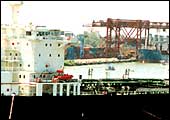 The
Kochi Port is often criticised for being unable to handle the
seafood and spice exports that pass through it. According to the
Seafood Exporters Association of India, over 300 containers, each
carrying 20 tonnes of cargo, were stuck at the port for weeks
last year, owing to heavy congestion. Says Kochi port Chairman
Jacob Thomas: "The problem happened due to a breakdown in
equipment and a surge in exports. Since then, we have had no issues
and we plan to become a regional hub in four years." The
Kochi Port is often criticised for being unable to handle the
seafood and spice exports that pass through it. According to the
Seafood Exporters Association of India, over 300 containers, each
carrying 20 tonnes of cargo, were stuck at the port for weeks
last year, owing to heavy congestion. Says Kochi port Chairman
Jacob Thomas: "The problem happened due to a breakdown in
equipment and a surge in exports. Since then, we have had no issues
and we plan to become a regional hub in four years."
-Rahul Sachitanand
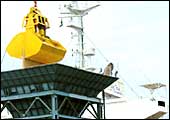 TUTICORIN,
Tamil Nadu TUTICORIN,
Tamil Nadu
CAPACITY: 16 MT
VESSEL SIZES: 50,000 DWT
TURNAROUND TIME: 2 days
INVESTMENTS: Rs 3,000 crore
Tuticorin Port,
which is spread over 2,500 acres, is not easily accessible. The
closest airport is in Madurai, around 170 km away. The port, which
is operating at over 100 per cent capacity, doesn't have any space
to spare, says Tuticorin port Deputy Chairman T. Balakrishnan.
But the Sethusamudram Project and the plans to deepen the anchorage
point and widen the port entrance are expected to improve the
situation. Further, the single lane approach road is being four
laned to provide easier access to the port, which handles commodities
like coal, fertilisers, salt, rice, sugar and stone.
-Rahul Sachitanand
KOLKATA-HALDIA,
West Bengal
CAPACITY: 46 MT
VESSEL SIZES: NA
TURNAROUND TIME: 2.94 days
INVESTMENTS: Rs 6,238 crore
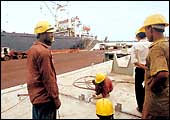 The
Kolkata Port has two dock systems-the Kolkata Dock System and
the Haldia Dock System. The biggest problems: high turnaround
times and low draught. Says A.K. Chanda, Chairman, Kolkata Port
Trust: "Our problems are not understood because we are the
only riverine port in the country." A CII official complains
that the port is over-congested. The roads leading to the ports
are also in very poor shape. Tea, leather goods, jute products
and processed foods are the main items handled here. The
Kolkata Port has two dock systems-the Kolkata Dock System and
the Haldia Dock System. The biggest problems: high turnaround
times and low draught. Says A.K. Chanda, Chairman, Kolkata Port
Trust: "Our problems are not understood because we are the
only riverine port in the country." A CII official complains
that the port is over-congested. The roads leading to the ports
are also in very poor shape. Tea, leather goods, jute products
and processed foods are the main items handled here.
-Charudutta Jena
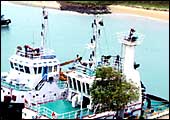 PARADIP,
Orissa PARADIP,
Orissa
CAPACITY: 30 MT
VESSEL SIZES: 70,000 DWT
TURNAROUND TIME: 2.72 days
INVESTMENTS: Rs 2,405 crore
The Paradip
Port handles iron, manganese and chrome ores, fertilizers and
charge chrome. Its advantages: the absence of rocky bottoms and
a tranquil harbour. But its problems far outweigh these pluses.
Admits Subrat Tripathi, Deputy Chairman of the port: "Three
things are vital to a port's functioning: smooth entry, storage
and exit of cargo." He adds: "Our performance has been
hampered by poor road and rail connectivity." The two main
roads connecting Paradip to the rest of India witness daily jams.
These are being four-laned and will be ready next year. A four-track
freight service linking Paradip with Cuttack will also be ready
next year. Till then, users will continue to suffer.
-Charudutta Jena
JNPT, Maharashtra
CAPACITY: 33 MT
VESSEL SIZES: 85,000 DWT
TURNAROUND TIME: Less than 1 day
INVESTMENTS: Rs 15,877 crore
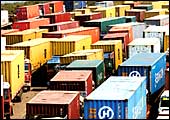 Jawaharlal
Nehru Port Trust (JNPT) is located in a deep, natural harbour
and has sufficient back-up area that can accommodate any expansion
plans in the foreseeable future. Its average turnaround time of
less than one day is the shortest in India and comparable to any
major port anywhere in the world. According to Ravi Budhiraja,
Chairman, JNPT, there is no congestion at the port. But it faces
a shortage of container handling capacities and lacks back-up
infrastructure for ship repairs. Extortion by the local mafia
is also a problem here. The port handles 60 per cent of India's
containerised traffic. Jawaharlal
Nehru Port Trust (JNPT) is located in a deep, natural harbour
and has sufficient back-up area that can accommodate any expansion
plans in the foreseeable future. Its average turnaround time of
less than one day is the shortest in India and comparable to any
major port anywhere in the world. According to Ravi Budhiraja,
Chairman, JNPT, there is no congestion at the port. But it faces
a shortage of container handling capacities and lacks back-up
infrastructure for ship repairs. Extortion by the local mafia
is also a problem here. The port handles 60 per cent of India's
containerised traffic.
-Priyanka Sangani
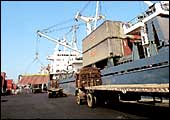 MUMBAI,
Maharashtra MUMBAI,
Maharashtra
CAPACITY: 35 MT
VESSEL SIZES: NA
TURNAROUND TIME: 3 days
INVESTMENTS: Rs 1,948 crore
This 130-year-old
port has been long associated with shipping in Mumbai; the city
alone contributes 28 per cent of its total traffic. Ankit Miglani,
Director, Uttam Galva Steel, has no complaints about this port,
which he uses for both exports and imports. "The port is
extremely efficient and functions very smoothly. The clearing
doesn't take very long," he says. The ample space it has
is a huge plus and ensures that there are no unnecessary delays.
This is what sets it apart from most other ports in India. Mumbai
port is used mainly for bulk and liquid cargoes and also runs
and operates its own railway.
Priyanka Sangani
|





 Capacity:
50 MT
Capacity:
50 MT  The
Chennai Port is often crippled by strikes. The infrastructure
is also near breaking point. Says an official of Toyota Kirloskar
Motor, which exports cars from the port: "Our volumes have
jumped from 1,120 in 2000 to 8,189 in 2005, but facilities at
the port just haven't kept pace." The customs department
works only five days a week. This means ships arriving at the
port after office hours on Friday have to wait till Monday morning
for clearance. Admits K. Suresh, Chairman of the port: "We
can't really compare ourselves with global hubs like Singapore."
The
Chennai Port is often crippled by strikes. The infrastructure
is also near breaking point. Says an official of Toyota Kirloskar
Motor, which exports cars from the port: "Our volumes have
jumped from 1,120 in 2000 to 8,189 in 2005, but facilities at
the port just haven't kept pace." The customs department
works only five days a week. This means ships arriving at the
port after office hours on Friday have to wait till Monday morning
for clearance. Admits K. Suresh, Chairman of the port: "We
can't really compare ourselves with global hubs like Singapore." MORMUGAO
MORMUGAO The
Kochi Port is often criticised for being unable to handle the
seafood and spice exports that pass through it. According to the
Seafood Exporters Association of India, over 300 containers, each
carrying 20 tonnes of cargo, were stuck at the port for weeks
last year, owing to heavy congestion. Says Kochi port Chairman
Jacob Thomas: "The problem happened due to a breakdown in
equipment and a surge in exports. Since then, we have had no issues
and we plan to become a regional hub in four years."
The
Kochi Port is often criticised for being unable to handle the
seafood and spice exports that pass through it. According to the
Seafood Exporters Association of India, over 300 containers, each
carrying 20 tonnes of cargo, were stuck at the port for weeks
last year, owing to heavy congestion. Says Kochi port Chairman
Jacob Thomas: "The problem happened due to a breakdown in
equipment and a surge in exports. Since then, we have had no issues
and we plan to become a regional hub in four years." TUTICORIN
TUTICORIN The
Kolkata Port has two dock systems-the Kolkata Dock System and
the Haldia Dock System. The biggest problems: high turnaround
times and low draught. Says A.K. Chanda, Chairman, Kolkata Port
Trust: "Our problems are not understood because we are the
only riverine port in the country." A CII official complains
that the port is over-congested. The roads leading to the ports
are also in very poor shape. Tea, leather goods, jute products
and processed foods are the main items handled here.
The
Kolkata Port has two dock systems-the Kolkata Dock System and
the Haldia Dock System. The biggest problems: high turnaround
times and low draught. Says A.K. Chanda, Chairman, Kolkata Port
Trust: "Our problems are not understood because we are the
only riverine port in the country." A CII official complains
that the port is over-congested. The roads leading to the ports
are also in very poor shape. Tea, leather goods, jute products
and processed foods are the main items handled here. PARADIP
PARADIP Jawaharlal
Nehru Port Trust (JNPT) is located in a deep, natural harbour
and has sufficient back-up area that can accommodate any expansion
plans in the foreseeable future. Its average turnaround time of
less than one day is the shortest in India and comparable to any
major port anywhere in the world. According to Ravi Budhiraja,
Chairman, JNPT, there is no congestion at the port. But it faces
a shortage of container handling capacities and lacks back-up
infrastructure for ship repairs. Extortion by the local mafia
is also a problem here. The port handles 60 per cent of India's
containerised traffic.
Jawaharlal
Nehru Port Trust (JNPT) is located in a deep, natural harbour
and has sufficient back-up area that can accommodate any expansion
plans in the foreseeable future. Its average turnaround time of
less than one day is the shortest in India and comparable to any
major port anywhere in the world. According to Ravi Budhiraja,
Chairman, JNPT, there is no congestion at the port. But it faces
a shortage of container handling capacities and lacks back-up
infrastructure for ship repairs. Extortion by the local mafia
is also a problem here. The port handles 60 per cent of India's
containerised traffic. MUMBAI
MUMBAI